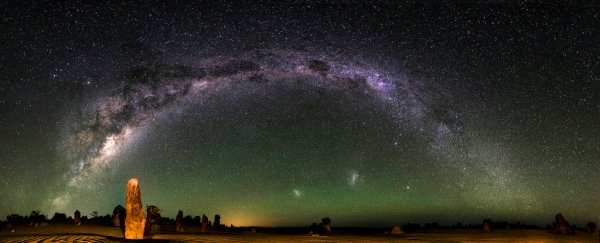We humans spend a lot of time celebrating the procession of Earth around the Sun, with New Year's celebrations happening each year just to mark the occasion.
But what about the fact that, even when we're standing still, we're moving around the Milky Way at roughly 828,000 km/h (514,000 mph), thanks to the orbit of our poor, under-appreciated Sun?
In order to give it some love, a group of science enthusiasts have just proposed a brand new space holiday called Galactic Tick Day, which celebrates the path the Sun takes around our galaxy.
Unfortunately, it takes the Sun anywhere between 220 million to 250 million years to complete its journey, so to make it a little more palatable, the creators of Galactic Tick Day have divided it up so that the holiday occurs roughly every 1.74 Earth years.
And, you're in luck, because the first ever Galactic Tick Day just happens to be today, 29 September 2016. Hooray, guys, we just made it a little further around the galaxy!
The unofficial holiday was created to remind people just how vast our Universe really is, and communicate the fact that it's not just planets that orbit stars, but also stars that orbit the centre of galaxies.
"Hopefully, some people will realise that the Sun is in motion, when they may have thought it was stationary before," 26-year-old David Sneider, one of the creators of the holiday, told Calla Cofield at Space.com.
"And perhaps for people who already know about this motion and know something about astronomy, if they're educating their peers and their friends … that's also something really nice."
Sneider isn't a scientist, but he loves getting people to think more deeply about the Universe and their place in it, and hopes the holiday will be an inspiring reminder that we're never standing still.
"All of these scientific facts, when you put them together and start synthesising [them] it becomes very invigorating," he told Space.com.
"This is a planetary society. Whether we like it or not we're all in it together. And to be able to have that level of conversation and kind of see people arrive at insights similar to that through science education is really amazing."
So how do you measure Galactic Tick Day? Well, in order to figure out how far the Sun is on its journey around the Milky Way, you need some kind of starting point - like January 1. Seeing as the Earth formed approximately 4.5 billion years ago, we can say it's already gone through about 20 complete loops around the galaxy.
But humans are newer to the story, and to be able to create our own celebration, we need a more recent reference point. Sneider and the other organisers chose 2 October 1608, which is the day German-Dutch spectacle-maker, Hans Lippershey, filed the patent for the first telescope.
That day was chosen because the telescope has been crucial in delivering "awareness of the nature of the Universe", according to the Galactic Tick Day site.
But once you've got a reference point, there's still the issue of breaking down the Sun's orbit into chunks that humans can relate to. To do that, the creators took the Sun's almost circular orbit around the centre of the Milky Way and broke it down into degrees.
The whole circle has 360 degrees, and each of those degrees can be divided up into 60 pieces, called an arc minute. Each of those arc minutes has 60 arc seconds, and Galactic Tick Day divides each of those arc seconds by 100, or 'centi-arc seconds'.
The holiday celebrates each time the Sun has moved one centi-arc seconds, which occurs every 633.7 days. (The creators call it a 'tick' because you can compare it to the second hand on a clock moving around its face.)
The team now wants the public to calculate when the next one will fall.
Getting traction is now the challenging part, but the creators are in it for the long haul.
"It's just an idea … It's successful if people are talking about it," Sneider told Space.com.
"I'm actually pretty surprised to see how excited people are getting about it … It took the founders of Mother's Day about two to three decades to get that going. And, you know, if this has some iota of traction in the next 10 to 15 years, I'll consider that a success."
